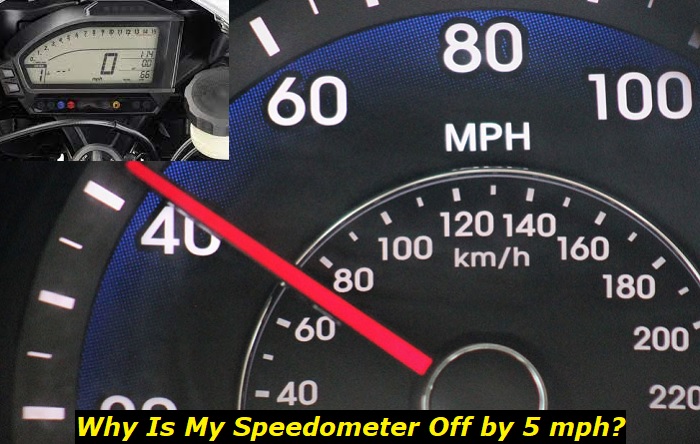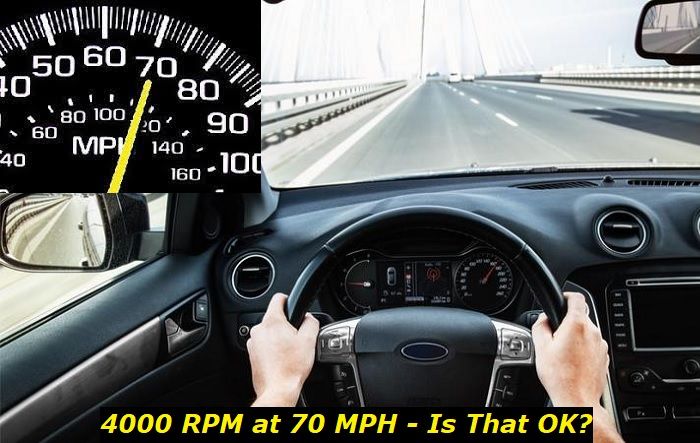You are humming along to the radio's music while driving and your eyes move toward the direction of your speedometer. The gauge says you are doing 70 mph even though you are pretty sure it's 65.
For some people, the speedometer's inaccurate readings fluctuate depending on the speed. So the readings could be off by 5 mph at lower speeds and double that number at higher speeds.
Before you panic over the situation, note that car or even motorcycle speedometers are sometimes made to display a certain percentage different from their actual readings. Manufacturers include this perhaps as a safety feature. So you are probably still within the speed limit despite what the failing speedometer says.

But of course, you should never be comfortable with an inaccurate speedometer. You will get a better understanding of how your speedometer works, a possible diagnosis of the issue, and the easiest ways to fix problems with an inaccurate vehicle speedometer.
How Does a Car Speedometer Work?
An inaccurate speedometer could leave you driving sluggishly or unconsciously going over the speed limit so it's recommended to always verify your vehicle's speedometer's accuracy. Doing this comes easier if you fully understand how a car's speedometer works.
Your vehicle's speedometer measures the rotations of the wheel or driveshaft. It gauges the spinning speed of these wheels through the transmission's speed sensor. A speedometer will not exactly provide results about how fast you are moving from point A to B. Rather, the rotations plus a set of arithmetic activities as determined by your vehicle, help specify your speed.
Regardless, the degree of accuracy a car's speedometer displays is greatly influenced by the wheels or their diameter. If you drive a classic car or have used your current car for a while, you can agree that the speedometer readings have not remained the same all through the years.
But this again depends on whether or not you've changed the car's tires since you first started to drive it. This implies that new tires, especially those with a bigger diameter will deliver faster speed. Similarly, smaller or under-inflated tires mean your readout would display a slower speed.
Also, keep in mind that a speedometer differs significantly from an odometer. While a speedometer displays how fast a vehicle travels, an odometer's main focus is to show distance. Unlike the accurate readings odometers are made to produce, the accuracy of a speedometer can be altered with calibration.
What can Cause a Speedometer to be off by 5 mph?
Your car or motorcycle's speedometer being below or over 5 percent can be a problem caused by one of the speedometer's many components. Inaccurate readings sometimes progress into completely non-functional speedometers and that usually comes with other signs.
You could be experiencing this current problem because of some damaged wiring or a blown fuse in the unit. A faulty sensor or changes in the wheels could also be causing the miscalculations. Let's consider a few of these causes in depth.
- Tire pressure and load
Most cases of speedometers being off by 5 mph result from changes in tire size. As you use your vehicle over the years, under-inflation affects the diameter of its tires, resulting in faster rotations and unusually high readings.
If you started experiencing off readings after increasing or decreasing your tire sizes, then that's likely what is causing the issue.
- Low brake fluid
You might also want to check your brake fluid to be sure it's not low. Inspect the brake light when it's illuminated and pump the e-brake lever continuously. If the light fluctuates as you pump, then the brake fluid might be low even though the switch is okay. Some people report that fixing the leak after finding their master cylinder empty helped resolve the issue.
- Faulty speedometer sensor
The speedometer sensor sits in the vehicle's transmission and accounts for the driveshaft's rotational speed. This information is then sent through the speedometer cable and to your car's computer which does the arithmetic work and tells you how fast you are driving.
Your speedometer displaying inaccurate readings is one of the most common signs that there is a problem with the speedometer sensor. A faulty sensor would cause the speedometer to produce changing speeds, even when you are not increasing or decreasing your speed in reality. There are a few other signs to look for out to confirm your suspicions about your speedometer sensor being faulty:
- Check engine light comes on the dashboard
- Vehicle power reduces, resulting in improper shifting that can damage internal components
- Faulty cruise control
- Malfunctioning odometer/ speedometer
How to Fix an Inaccurate Speedometer Reading
Your speedometer reading being off by 1 or 2 mph is probably not a big deal but with 5 mph, you should take immediate action to rectify the fault. Here are a few things you can do to do:
1. Calibrate the speedometer
Speedometer calibration depends on the original tires of the vehicle. Normal wear and tear can cause the treads on your tires to become weak and need replacement and this affects the numbers your speedometer displays. When replacing old tires, ensure you are using parts rated for your car as the wrong gear can also result in inaccurate speedometer readings. You can choose to take the vehicle to a tuner to alter the tire size.
If you use an electric speedometer, here are steps to follow to calibrate it:
- Push and hold the calibration button, then start the car while at it. Hold down the button some more and release only after the pointer has gotten to the full scale.
- Drive to the start of a pre-marked two-mile distance and do not shut the engine.
- Push and release the button afterward for the pointer to drop to half-scale.
- While driving the two-mile distance, you might notice the speedometer counting pulses. This is nothing to worry about.
- At the end of the pre-marked distance, stop, push, and release the calibration button so that the pointer drops to zero.
2. Replace the transmission speed sensor
If the inaccurate readings are the result of a faulty transmission speed sensor, fix that following these steps:
- Lift and support the car with a jack stand
- Remove the sensor from the speed housing
- Install the new transmission speed sensor
- Clear any diagnostic trouble codes and test-drive the vehicle.
How Do You Spot Inaccurate Speedometer Readings?
Comparing your speedometer readings with your correct driving speed becomes necessary when experiencing errors like an off reading.
The first method is to drive your car to an empty flat highway that has mile markers and a speed limit of more than 60 miles per hour. Go with someone else and hand them a stopwatch. You should drive 60 seconds per mile and have the other person monitor this as you drive. Repeat this a few more times and compare the average speed to what your speedometer is displaying.
The GPS method is another efficient way to verify your actual speed. The results a GPS device would provide would differ from the readings your speedometer is displaying. Unlike the speedometer result that's affected by wheel size and drive ratios, a good GPS device provides results without these factors in the picture.
Does this mean speedometers are inaccurate? Not in that sense. You can trust your speedometer's readings in normal circumstances but still, take precautions when driving on the highway. Other factors like using the correct tires for your vehicle help the speedometer deliver reliable results.
Should You Drive with a Speedometer That is Off by 5 mph?
Driving with an inaccurate speedometer can be inconvenient and have worse consequences. Imagine having to deal with an engine problem simply because you ignored speedometer problems. There is also the risk of an accident so you could be endangering your life, those of your passengers, and other motorists.
If an accurate speedometer is also a requirement to complete a vehicle inspection process, you will remain stuck.
Worst of all, you risk being handed a ticket by law enforcement because you cannot recognize the speed at which your vehicle is traveling with a malfunctioning speedometer. So while you can decide to go on with driving, keep all of these in mind if you'll be driving with a faulty speedometer.
In the meantime, consider using the GPS in your smartphone or a reliable speed-tracking app to monitor your driving speed. Do this cautiously though, as these alternatives may not be as accurate.
Conclusion
Since your vehicle's speedometer reading may be off for many reasons, you might need to do a few checks to determine the actual problem. It's also smart to check the speedometer's accuracy frequently so you can detect any problems on time.
Always knowing how fast you are driving is super important so while "5 mph off" might seem like nothing, get your speedometer running normally again as soon as you can.
About the authors
The CarAraC research team is composed of seasoned auto mechanics and automotive industry professionals, including individuals with advanced degrees and certifications in their field. Our team members boast prestigious credentials, reflecting their extensive knowledge and skills. These qualifications include: IMI: Institute of the Motor Industry, ASE-Certified Master Automobile Technicians; Coventry University, Graduate of MA in Automotive Journalism; Politecnico di Torino, Italy, MS Automotive Engineering; Ss. Cyril and Methodius University in Skopje, Mechanical University in Skopje; TOC Automotive College; DHA Suffa University, Department of Mechanical Engineering






Add comment